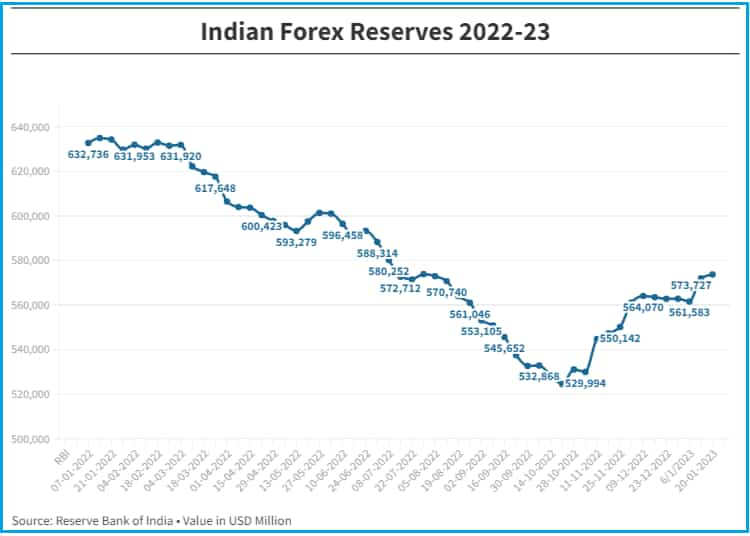In the complex world of international finance, foreign exchange (forex) reserves play a crucial role in maintaining economic stability and ensuring access to foreign exchange for essential imports. India’s forex reserves, in particular, represent its financial strength and resilience in the global arena.

Image: www.zeebiz.com
Join us as we delve into the enigmatic world of forex India, exploring its definition, composition, and significance. Together, let’s gain a comprehensive understanding of this economic powerhouse and unlock its secrets.
Defining Forex India
Forex India refers to the total amount of foreign currency reserves held by the Reserve Bank of India (RBI), India’s central bank. These reserves are accumulated through various sources, such as foreign direct investment, trade transactions, and foreign currency swaps.
Comprising currencies from various countries, including the US dollar, euro, and pound sterling, forex India acts as a financial cushion for the Indian economy. It enables the RBI to intervene in the foreign exchange market, manage exchange rate volatility, and ensure the uninterrupted inflow of essential imported goods.
Significance of Forex India
India’s forex reserves hold immense significance for its economic growth and financial resilience. They provide the RBI with the ability to:
- Stabilize the Currency: By intervening in the forex market, the RBI can manage exchange rate fluctuations and prevent excessive volatility, thereby protecting the value of the Indian rupee.
- Meet Import Obligations: Forex reserves serve as a buffer to cover the import bill, ensuring that India has access to crucial imports, such as oil, commodities, and capital goods.
- Maintain Confidence: Ample forex reserves boost investor and business confidence, as they indicate India’s financial stability and ability to meet its external obligations.
- Enhance Credit Rating: Strong forex reserves enhance India’s credit rating, making it more attractive to foreign investors and securing access to favorable loan terms.
Latest Trends and Developments
India’s forex reserves have witnessed significant growth in recent years, reaching record levels above 600 billion US dollars. This growth has been largely driven by a surge in foreign direct investment, portfolio inflows, and remittances from overseas Indians.
However, global economic uncertainties, currency wars, and geopolitical tensions have also impacted forex India. The RBI has been proactive in managing these external factors, using a combination of market interventions and prudent reserve management strategies.

Image: www.pelletplus.hu
Tips for Managing Forex India
The RBI employs an array of strategies to manage forex India effectively. Here are some key tips:
- Diversify Reserves: Holding reserves in multiple currencies reduces the risk of currency fluctuations and minimizes potential losses.
- Invest Surplus Reserves: The RBI invests a portion of surplus forex reserves in safe and high-yield assets, such as sovereign bonds and gold, to generate earnings.
- Monitor Economic Trends: Constant vigilance of global economic indicators, exchange rate movements, and capital flows helps the RBI anticipate and respond to market developments promptly.
- Utilize Forward Contracts: Forward contracts enable the RBI to lock in a favorable exchange rate in advance, hedging against potential fluctuations.
These strategies have proven effective in safeguarding the value of forex India and ensuring its stability amidst market volatility.
FAQs on Forex India
Q: What is the difference between forex and foreign currency reserves?
A: Forex refers to the foreign currency market where currencies are traded freely. Forex India, on the other hand, is the total foreign currency reserves held by the Reserve Bank of India.
Q: How does the RBI use forex reserves to manage the economy?
A: The RBI uses forex reserves to stabilize the exchange rate, meet import obligations, maintain investor confidence, and enhance India’s credit rating.
Q: What are the factors influencing forex India?
A: Global economic uncertainties, currency wars, geopolitical tensions, foreign direct investment, portfolio inflows, and remittances from overseas Indians all impact forex India.
Forex India Of Reserve Is Defined As
Conclusion
Forex India is a vital component of India’s financial landscape, providing a buffer against global economic uncertainties and facilitating access to essential imports. By adopting prudent reserve management strategies and staying abreast of market trends, the RBI ensures the stability and resilience of forex India.
Are you fascinated by the world of forex and its impact on the global economy? If so, join us for an in-depth exploration of this dynamic field. Together, let’s unlock the secrets of forex and its impact on the Indian economy.






